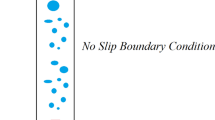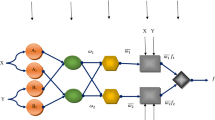Abstract
Prediction of fluid pattern inside chemical mixing tanks and reactors is very challenging, mainly when scale-up and optimization of devices are essential due to enormous computational time and experimental efforts. This work recommends a new prediction tool to understand fluid behavior on the smart neural nodes. The adaptive neuro-fuzzy inference system (ANFIS) is used to learn the lattice Boltzmann method (LBM) data and predict fluid patterns based on its understanding. The anticipated results with the integration of LBM and ANFIS method indicated a good agreement with existing computational fluid dynamics results. The results show that almost similar fluid pattern occurs on neural nodes in the ANFIS method compared by LBM on lattice unit when shear flow applies on the top and bottom of fluid structure. This finding is very promising to avoid substantial computational time or experimental efforts in the optimization of different chemical devices. Prediction of the shear flow and optimization of boundary conditions to get proper droplet size distribution or bubble size distribution requires heavy computational time. Therefore in this work, ANFIS approach besides the LB method was used to replicate the flow between two parallel plates (vortex structure) in a short computational time. The current overview also shows the ability of the ANFIS method as a machine learning tool to learn how the fluid is disturbed by shear flow. The input data are used as big data during the learning process, and the intelligence of the algorithm is examined based on the total percentage of training data.














Similar content being viewed by others
References
Kang Q, Zhang D, Chen S, He X (2002) Lattice Boltzmann simulation of chemical dissolution in porous media. Phys Rev E Stat Nonlin Soft Matter Phys 65(3 Pt 2B):036318
Bae C-Y, Kang YG, Kim S, Cho C, Kang HC, Yu BY, Lee S-W, Cho KH, Lee DC, Lee K, Kim JS, Shin KK (2008) Development of models for predicting biological age (BA) with physical, biochemical, and hormonal parameters. Arch Gerontol Geriatr 47(2):253–265
Yu H, Luo L-S, Girimaji SS (2002) Scalar mixing and chemical reaction simulations using Lattice Boltzmann method. Inter J Comput Eng Sci 03(01):73–87
Wu X, Wang J, Cui X, Maianu L, Rhees B, Rosinski J, Venus So W, Willi SM, Osier MV, Hill HS, Page GP, Allison DB, Martin M, Timothy Garvey W (2007) The effect of insulin on expression of genes and biochemical pathways in human skeletal muscle. Endocrine 31(1):5–17
Versteeg HK, Malalasekera W (2007) An introduction to computational fluid dynamics: the finite volume method. Pearson Education, London
Fei L, Luo KH (2018) Cascaded lattice Boltzmann method for thermal flows on standard lattices. Int J Therm Sci 132:368–377
Ahmad R, Farooqi A, Zhang J, Ali N (2019) Steady flow of a power law fluid through a tapered non-symmetric stenotic tube. Appl Math Nonlinear Sci 4:249–260
Fei L, Luo KH, Lin C, Li Q (2018) Modeling incompressible thermal flows using a central-moments-based lattice Boltzmann method. Int J Heat Mass Transf 120:624–634
Seta T, Hayashi K, Tomiyama A (2018) Analytical and numerical studies of the boundary slip in the immersed boundary-thermal lattice Boltzmann method. Int J Numer Methods Fluids 86:454–490
Wang Y, Shu C, Huang H, Teo C (2015) Multiphase lattice Boltzmann flux solver for incompressible multiphase flows with large density ratio. J Comput Phys 280:404–423
Çitil HG (2019) Applied mathematics and nonlinear sciences: important notes for a fuzzy boundary value problem. Appl Math Nonlinear Sci 4:305–314
Yaseen ZM, Sulaiman SO, Deo RC, Chau K-W (2018) An enhanced extreme learning machine model for river flow forecasting: state-of-the-art, practical applications in water resource engineering area and future research direction. J Hydrol 569:387–408
Babanezhad M, Rezakazemi M, Hajilary N, Shirazian S (2019) Liquid-phase chemical reactors: development of 3D hybrid model based on CFD-adaptive network-based fuzzy inference system. Can J Chem Eng 97(S1):1676–1684
Pourtousi M, Sahu JN, Ganesan P, Shamshirband S, Redzwan G (2015) A combination of computational fluid dynamics (CFD) and adaptive neuro-fuzzy system (ANFIS) for prediction of the bubble column hydrodynamics. Powder Technol 274:466–481
Pourtousi M, Zeinali M, Ganesan P, Sahu JN (2015) Prediction of multiphase flow pattern inside a 3D bubble column reactor using a combination of CFD and ANFIS. RSC Adv 5(104):85652–85672
Dashti A, Harami HR, Rezakazemi M (2018) Accurate prediction of solubility of gases within H2-selective nanocomposite membranes using committee machine intelligent system. Int J Hydrog Energy 43:6614–6624
Wang W-C, Chau K-W, Qiu L, Chen Y-B (2015) Improving forecasting accuracy of medium and long-term runoff using artificial neural network based on EEMD decomposition. Environ Res 139:46–54
Soroush E, Mesbah M, Hajilary N, Rezakazemi M (2019) ANFIS modeling for prediction of CO2 solubility in potassium and sodium based amino acid Salt solutions. J Environ Chem Eng 7:102925
Rezakazemi M, Shirazian S (2019) Gas–liquid phase recirculation in bubble column reactors: development of a hybrid model based on local CFD–adaptive neuro-fuzzy inference system (ANFIS). J Non-Equilib Thermodyn 44:29–42
Rezakazemi M, Mosavi A, Shirazian S (2019) ANFIS pattern for molecular membranes separation optimization. J Mol Liq 274:470–476
Rezakazemi M, Shirazian S (2018) Development of a 3D hybrid intelligent-mechanistic model for simulation of multiphase chemical reactors. Chem Eng Technol 41:1982–1993
Rezakazemi M, Azarafza A, Dashti A, Shirazian S (2018) Development of hybrid models for prediction of gas permeation through FS/POSS/PDMS nanocomposite membranes. Int J Hydrog Energy 43:17283–17294
Dashti A, Riasat Harami H, Rezakazemi M, Shirazian S (2018) Estimating CH4 and CO2 solubilities in ionic liquids using computational intelligence approaches. J Mol Liq 271:661–669
Dashti A, Asghari M, Dehghani M, Rezakazemi M, Mohammadi AH, Bhatia SK (2018) Molecular dynamics, grand canonical Monte Carlo and expert simulations and modeling of water–acetic acid pervaporation using polyvinyl alcohol/tetraethyl orthosilicates membrane. J Mol Liq 265:53–68
Rezakazemi M, Dashti A, Asghari M, Shirazian S (2017) H2-selective mixed matrix membranes modeling using ANFIS, PSO-ANFIS, GA-ANFIS. Int J Hydrog Energy 42:15211–15225
Rezakazemi M, Ghafarinazari A, Shirazian S, Khoshsima A (2012) Numerical modeling and optimization of wastewater treatment using porous polymeric membranes. Polym Eng Sci 53:1272–1278
Lei Y, He Z, Zi Y, Hu Q (2007) Fault diagnosis of rotating machinery based on multiple ANFIS combination with GAs. Mech Syst Signal Process 21:2280–2294
Yilmaz I, Kaynar O (2011) Multiple regression, ANN (RBF, MLP) and ANFIS models for prediction of swell potential of clayey soils. Expert Syst Appl 38:5958–5966
Author information
Authors and Affiliations
Corresponding author
Ethics declarations
Conflict of interest
The authors declare that they have no conflict of interest.
Additional information
Publisher's Note
Springer Nature remains neutral with regard to jurisdictional claims in published maps and institutional affiliations.
Rights and permissions
About this article
Cite this article
Cao, Y., Babanezhad, M., Rezakazemi, M. et al. Prediction of fluid pattern in a shear flow on intelligent neural nodes using ANFIS and LBM. Neural Comput & Applic 32, 13313–13321 (2020). https://doi.org/10.1007/s00521-019-04677-w
Received:
Accepted:
Published:
Issue Date:
DOI: https://doi.org/10.1007/s00521-019-04677-w




